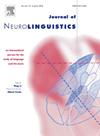The neural mechanisms of bilinguals’ creativity: A neuroimaging study
IF 1.2
3区 心理学
Q2 LINGUISTICS
引用次数: 0
Abstract
Prior research has established a positive link between bilingualism and creativity. However, despite clear evidence for the positive role of L2 proficiency in creativity, few neuroimaging studies have provided insights into its underlying neural mechanisms. To bridge this gap, we employed a chain free association task and functional near-infrared spectroscopy (fNIRS) to capture cortical activity in the temporo-parietal junction (TPJ) and the frontopolar cortex (FPC) during the task. Our behavioral results confirmed a positive association between L2 proficiency and creative performance. Neuroimaging data revealed that TPJ activity in bilinguals positively correlated with their creativity, while FPC activity was negatively correlated with their creativity. Furthermore, mediation analysis indicated that both TPJ and FPC activity mediated the relationship between L2 proficiency and creative performance. These preliminary findings suggest the potential involvement of both the default mode network (DMN) and the executive function network (EFN) in bilinguals’ creative cognition.
双语者创造力的神经机制:一项神经影像学研究
先前的研究已经确立了双语能力和创造力之间的积极联系。然而,尽管有明确的证据表明第二语言熟练度对创造力有积极作用,但很少有神经影像学研究能深入了解其潜在的神经机制。为了弥补这一空白,我们采用了一个无链关联任务和功能性近红外光谱(fNIRS)来捕捉任务期间颞顶叶交界处(TPJ)和额极皮层(FPC)的皮层活动。我们的行为结果证实了第二语言熟练程度和创造性表现之间的正相关。神经影像学数据显示,双语者TPJ活性与创造力呈正相关,FPC活性与创造力呈负相关。此外,中介分析表明TPJ和FPC活动在第二语言熟练程度和创造性表现之间都起中介作用。这些初步发现表明,默认模式网络(DMN)和执行功能网络(EFN)都可能参与双语者的创造性认知。
本文章由计算机程序翻译,如有差异,请以英文原文为准。
求助全文
约1分钟内获得全文
求助全文
来源期刊

Journal of Neurolinguistics
医学-神经科学
CiteScore
3.90
自引率
5.00%
发文量
49
审稿时长
17.2 weeks
期刊介绍:
The Journal of Neurolinguistics is an international forum for the integration of the neurosciences and language sciences. JNL provides for rapid publication of novel, peer-reviewed research into the interaction between language, communication and brain processes. The focus is on rigorous studies of an empirical or theoretical nature and which make an original contribution to our knowledge about the involvement of the nervous system in communication and its breakdowns. Contributions from neurology, communication disorders, linguistics, neuropsychology and cognitive science in general are welcome. Published articles will typically address issues relating some aspect of language or speech function to its neurological substrates with clear theoretical import. Interdisciplinary work on any aspect of the biological foundations of language and its disorders resulting from brain damage is encouraged. Studies of normal subjects, with clear reference to brain functions, are appropriate. Group-studies on well defined samples and case studies with well documented lesion or nervous system dysfunction are acceptable. The journal is open to empirical reports and review articles. Special issues on aspects of the relation between language and the structure and function of the nervous system are also welcome.
 求助内容:
求助内容: 应助结果提醒方式:
应助结果提醒方式:


